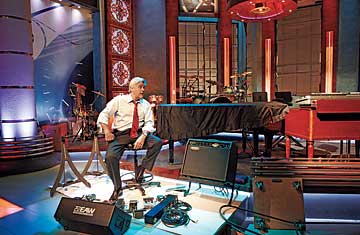
One challenge Leno, on his new set, faces is pleasing old fans without seeming to copy The Tonight Show.
(7 of 8)
In late night they did, but prime time is a question mark even for a known quantity like Leno. One possibility is that the show will seem, well, lame. I don't mean that as a judgment on Leno's comedy. If you think the Dancing Itos were an incisive work of satire, good on you. But TV is about context. When Letterman and O'Brien moved an hour earlier, they had to adapt their 12:30 comedy (edgy, niche) into 11:30 comedy (accessible, broader). Likewise, comedy that's familiar and soothing at bedtime could seem cheap or corny at the hour of CSI and cable dramas. Leno calls 10 p.m. "the new 11:30" for people exhausted by kids, work and so on. (Um, but they should stay up for Conan anyway, right? Leno feigns a flustered recovery. "Oh--yeah!")
Another possibility: maybe the show won't be lame at all. We know it will begin with a Tonight-style monologue and end with familiar Tonight gags. But in the middle, Leno will showcase new comics, like Jim Norton of shock-jock show Opie and Anthony. Maybe the new start will give Leno the eye of the tiger. (Like a boxer in training, he's already lost 12 pounds.) NBC recently ran a Blair Witch--like trailer for the show in theaters before movies like District 9. In it, Leno went on the lam after believing he killed someone in a hit-and-run. It was funny, fresh, against type--Conanesque, even.
A final possibility is that The Jay Leno Show will be just lame enough to be a hit. Leno has long been written off by people, especially in New York and L.A., who think his humor is toothless. But Middle America kept him at No. 1 for 15 of his 17 years on The Tonight Show. Advertisers have resisted paying prime-time rates up front for Leno's experiment, but Rino Scanzoni, chief investment officer for media buyer GroupM (which buys advertising time for corporate clients), says his research reveals healthy interest in the show in middle-American homes, nonurban homes and homes without DVRs. (The last is a mixed blessing for advertisers; these individuals watch more ads but have less money.)
In other words, there are still viewers in Leno's mainstream--or what's left of it. And this is NBC's paradoxical bet. The great American median is no longer a majority, if it ever was one. But as a niche, it still exists--older, less kowtowed to by advertisers and TV critics, still interested in simple old-fashioned TV. A lot of people, after all--about 16 million of them--are watching The Mentalist. NBC's modest dream is that some of them might watch Jay instead, maybe just a little, maybe when CBS is in reruns. Not a Silent Majority but maybe a Silent Decent-Size Minority.
The End of Mass
Ultimately, the great Leno gamble signals a change in TV, boom or bust. If it hits, other broadcasters will feel pressure to cut costs too, further driving creative TV to cable. If it fails, it will leave NBC in a bigger hole and desperate for other ways to downsize. Either way, creatively, the show is ushering in an era in which TV is both moving ahead (becoming more varied and experimental, especially on cable and online) and retrogressing into its past (on the broadcast networks), returning to TV's earliest days as a raw distribution medium for cheap content, with variety shows and built-in product placements.
